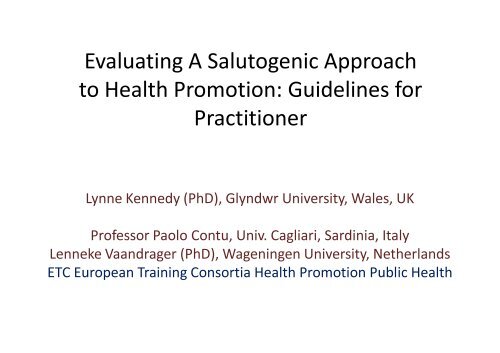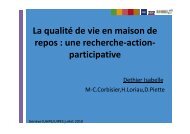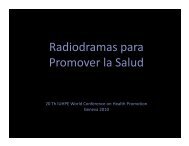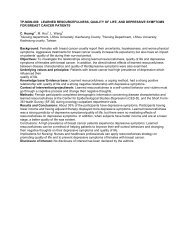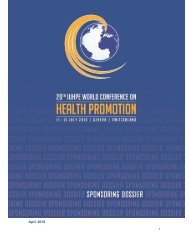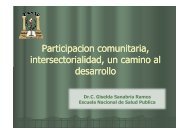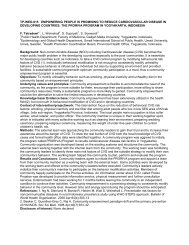Evaluating A Salutogenic Approach to Health Promotion - Iuhpe ...
Evaluating A Salutogenic Approach to Health Promotion - Iuhpe ...
Evaluating A Salutogenic Approach to Health Promotion - Iuhpe ...
Create successful ePaper yourself
Turn your PDF publications into a flip-book with our unique Google optimized e-Paper software.
<strong>Evaluating</strong> A <strong>Salu<strong>to</strong>genic</strong> <strong>Approach</strong><strong>to</strong> <strong>Health</strong> <strong>Promotion</strong>: Guidelines forPractitionerLynne Kennedy (PhD), Glyndwr University, Wales, UKProfessor Paolo Contu, Univ. Cagliari, Sardinia, ItalyLenneke Vaandrager (PhD), Wageningen University, NetherlandsETC European Training Consortia <strong>Health</strong> <strong>Promotion</strong> Public <strong>Health</strong>
Session aimsTo engage in conversations on...• <strong>Salu<strong>to</strong>genic</strong> approaches and health promotionpractice• Why is evaluation problematic?• What alternatives are available <strong>to</strong> practitioners?
<strong>Salu<strong>to</strong>genic</strong> concept• Salus (health, invincibility, well being, happiness) genese (origin)
Salu<strong>to</strong>genesis and <strong>Health</strong> <strong>Promotion</strong>(WHO, 1986:1)“… is the process of enabling individuals andcommunities <strong>to</strong> increase control over, and <strong>to</strong>improve their health”• …is a resource for every day living, not theobjective or purpose of life
<strong>Salu<strong>to</strong>genic</strong> interpretation of theOttawa Charter”(Erikson & Lindstrom)• societies should empowerpeople <strong>to</strong> participate indecision making processes…people can create conditionsin which they can makecoherent experiences <strong>to</strong> buildup a strong SOC• Such societies promote healthand strengthen peoples´competences <strong>to</strong> manage theemerging problems of daily life
Evaluation and health promotion• <strong>Health</strong> promotion activity is a complex process• Involves highly subjective indica<strong>to</strong>rs• Evaluation is problematic; evidence base is (still)limited• What counts as evidence in health promotion isstrongly contested• Ideology and values and principles strongly influencewhat is accepted as valid evidence (EBP, e.g. NationalInstitute Clinical Excellence NICE)
Pathogenic /<strong>Salu<strong>to</strong>genic</strong> research & evaluation1. Epidemiological/demographic analysis1. Goal is health outcome2. Organised arounddisease categories3. Focus on weakness4. Asks ‘how we canmotivate people <strong>to</strong>do…?’1. Social analysis2. Goal is health outcomeAND increasedcommunitycompetence3. Organised aroundpeople4. Focus on strengths5. Asks ‘what are peoplesmotives?’
CASE STUDY:• In your tu<strong>to</strong>rial groups• clearly state your research aims and objectives• briefly outline your action plan/intervention• using a <strong>Salu<strong>to</strong>genic</strong> or asset based model identifya set of evaluation indica<strong>to</strong>rs (individual,community, organisation, policy) for your project• identify potential opportunities and issues arising• Feedback: briefly state your objectives ANDselect 2-3 examples of your ‘most’ salu<strong>to</strong>genicindica<strong>to</strong>rs
ConversationTurn <strong>to</strong> you partner and using an ‘asset’ ratherthan a ‘deficit’ model, identify two possibleindic<strong>to</strong>rs for each of the 3 levels:1. Individual2. Community3. Organization
Assets based model –(Morgan & Ziglio, 2006)• Redress balance between evidence for healthpromotion practice derived from deficit(problems) and asset (capability) model• Asset: Any fac<strong>to</strong>r or resource which enhances• Asset: Any fac<strong>to</strong>r or resource which enhancesthe ability of individuals, communities,populations, social systems or institutions <strong>to</strong>maintain and sustain health and wellbeing.
<strong>Health</strong> assets at individual level:• Social competence• Resistance skills• Commitment <strong>to</strong> learning• Positive values• Self esteem• Sense of purpose
At the community level:• Family and friendship (supportive) networks• Inter-generational solidarity• Community cohesion• Affinity groups (mutual aid)• Religious <strong>to</strong>lerance and harmony
At organisational level• Environmental resources necessary for promotingphysical, mental and social health• Employment security• Safe and pleasant housing and neighbourhoods• Political democracy• Participation opportunities• Social justice• Equity enhancing policies
<strong>Salu<strong>to</strong>genic</strong> health promotionresearch:• The problem may not be one of lack ofevidence but conceptualisation of health andwhere we look for evidence• We need a framework that helps understandcombined fac<strong>to</strong>rs required <strong>to</strong> effect andstrengthen population health and wellbeing• Need <strong>to</strong> employ participa<strong>to</strong>ry approaches
THANK YOU FOR LISTENINGQUESTIONS?
Key Sources• Wannamakers A, (2010)• Lindstrom, B. And Erikson, M (2005)Salu<strong>to</strong>genesis. J Epidemiology & community<strong>Health</strong>, 59 440-42;5• Federal Centre for <strong>Health</strong> (1999) What keepspeople healthy? The current state of discussionand the relevance of An<strong>to</strong>novosky’s <strong>Salu<strong>to</strong>genic</strong>Model of health• Morgan A & Ziglio E (2006) Revitalising theEvidence base for public health: an assets model
Community Asset mapping• A process that fully engages and mobilisescommunities themselves <strong>to</strong> use their ownassets <strong>to</strong> visualise a healthy neighbourhoodand community and <strong>to</strong> identify solutions or aplan <strong>to</strong> achieve this goal.• Thus, starting with ‘what the community has’and <strong>to</strong> utilise this in achieving a better qualityof life
Possible evaluation questions:• What are the key assets for health anddevelopment at each of the key stages of lifecourse?• What are the links between these assets andhealth outcomes?• How do these assets work <strong>to</strong>gether <strong>to</strong> bringabout the best health and well beingoutcomes?
• Identifying Asset based protective approaches and health add promoting value <strong>to</strong>fac<strong>to</strong>rs that traditional act <strong>to</strong>gether deficit <strong>to</strong> model support by: health andwell being• Develops policy options required <strong>to</strong> build andsustain the above• population is regarded as co-producer ofhealth, not only consumer of services• strengthening individual and communitycapacity <strong>to</strong> reach potential
Asset mapping• Takes positive approach <strong>to</strong> measuring anddiagnosing community capacity <strong>to</strong> engage inhealth development activities• Is a process of inven<strong>to</strong>ry of the strengths andgifts people who make up a community canbring <strong>to</strong> health – prior <strong>to</strong> intervention• Promotes a multidisciplinary approach <strong>to</strong>evaluation of complex interventions
Asset mapping...• Is a process of building trust betweenprofessionals and local communities• helps conceptualise what is salu<strong>to</strong>genic orhealth enhancing form the perspectives ofindividuals/ communities and within specificsocial and cultural context• raises self esteem and resourcefulness(empowers) individuals and communities
<strong>Health</strong> <strong>Promotion</strong> Strategies (WHO, 2005:3)• Advocate for health based on human rights andsolidarity• Invest in sustainable policies, actions andinfrastructure• Build capacity for policy development, leadership,health promotion practice, knowledge transferand research, and health literacy• Regulate and legislate <strong>to</strong> ensure a high level ofprotection from harm and enable equalopportunity for health and wellbeing for allpeople


